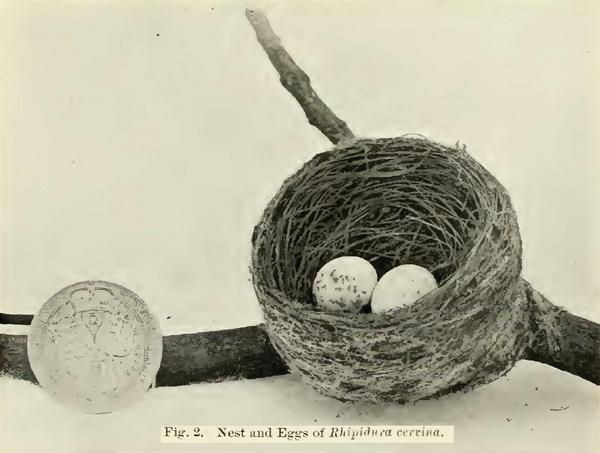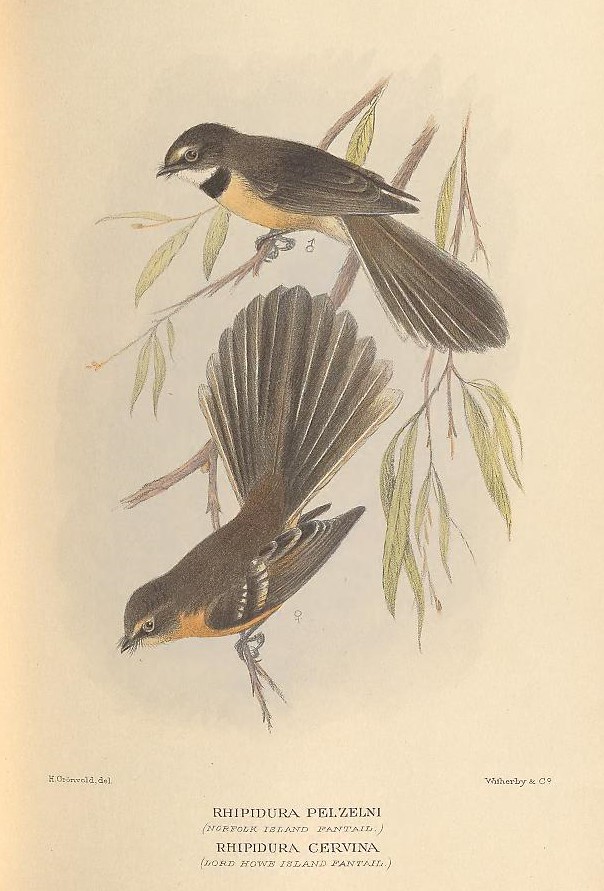Rhipidura fuliginosa cervina Ramsay, 1879:340
Lord Howe Island fantail
Taxonomy & Nomenclature
Synonym/s: Rhipidura cervina Ramsay, 1879:340; Rhipidura macgillivrayi Sharpe, 1881:789
Conservation Status
Extinct
Last record: 1924 (May or later, see Hindwood, 1940; Hutton, 1991:131)
IUCN RedList status: Extinct
Distribution
Lord Howe Island, New South Wales, Australia
Biology & Ecology
Hypodigm
Syntypes:
AM O.56997 (adult, female)
AM O.56998 (adult, unsexed)
BMNH 1881.5.1.559 (adult, male) (syntype of R. macgillivrayi)
Media

Above: the nest and two eggs. Published in Hull (1909). Source: Wikimedia Commons.

Above: illustration (bottom bird) from Mathews (1928).
References
Original scientific description:
Ramsay, E. P. (1879). Description of a new species of Rhipidura, from Lord Howe's Island. Proceedings of the Linnean Society of New South Wales 3: 340.
Other references:
BirdLife International. (2012). Rhipidura fuliginosa. In: IUCN 2012. IUCN Red List of Threatened Species. Version 2012.2. (http://www.iucnredlist.org). Downloaded on 29 May 2013.
Day, David. (1981). The Doomsday Book of Animals: A Natural History of Vanished Species. New York, N.Y.: The Viking Press.
Department of Environment and Climate Change (NSW). (2007). Lord Howe Island Biodiversity Management Plan Appendices. Department of Environment and Climate Change (NSW), Sydney. vii + 267 pp.
Etheridge, R. (1889). The general zoology of Lord Howe Island; containing also an account of the collections made by the Australian Museum Collecting Party, Aug.–Sept., 1887. Australian Museum Memoir 2(1): 1-42, plates iv–v.
Garnett, Stephen (ed.). (1992). Threatened and Extinct Birds of Australia. RAOU Report Number 82. 212 pp.
Garnett, S. T. and Crowley, G. M. (2000). The Action Plan for Australian Birds 2000. Canberra, ACT: Environment Australia & Birds Australia.
Hindwood, Keith A. (1938). The extinct birds of Lord Howe Island. Australian Museum Magazine 6(9): 319-324.
Hindwood, K. A. (1940). The birds of Lord Howe Island. Emu 40: 1-86.
Hull, Arthur Francis Basset. (1909). The birds of Lord Howe and Norfolk Islands. Proceedings of the Linnean Society of New South Wales 34: 636-693, pls. l-liv. [p. 683]
Hutton, Ian. (1991). Birds of Lord Howe Island: Past and Present. Coffs Harbour Plaza, N.S.W.: Self Published. 154 pp.
Knox, Alan G. and Walters, Michael P. (1994). Extinct and endangered birds in the collections of The Natural History Museum. British Ornithologists' Club Occasional Publications 1: 1-292. [pp. 222-223]
Mathews, Gregory Macalister. (1928). The Birds of Norfolk & Lord Howe Islands and the Australasian South Polar Quadrant: with additions to "birds of Australia". London: H.F. & G. Witherby. xii + 139 pp, pls 1-45. [p. 44, pl. 24]
McAllan, Ian A. W., Curtis, Brian R., Hutton, Ian and Cooper, Richard M. (2004). The Birds of Lord Howe Island Group: A Review of Records. Australian Field Ornithology 21(Supplement): 1-82.
McCulloch, Allan R. (1921). Lord Howe Island–a naturalist's paradise. Australian Museum Magazine 1(2): 31-47.
Recher, H. F. (1974). Colonisation and extinction: the birds of Lord Howe Island. Australian Natural History 18(2): 64-69.
Sharland, G. S. M. (1929). The land birds of Lord Howe Island. Emu 29: 5-11.
Sharpe, R. B. (1881). On some Flycatchers lately added to the collection of the British Museum. Proceedings of the Zoological Society of London 1881: 788-790.
Woinarski, John C. Z., Legge, Sarah M. and Garnett, Stephen T. (2024). Extinct Australian birds: numbers, characteristics, lessons and prospects. Emu 124(1): 8-20. https://doi.org/10.1080/01584197.2023.2240345
